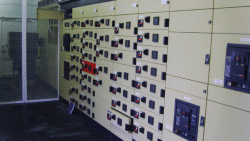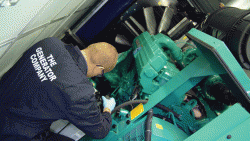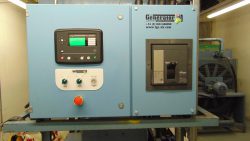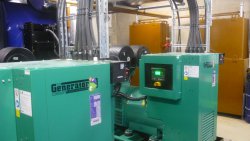750kVA Standby Generator System Upgrade at Leading Cancer Research Institute
Following a successful tender bid, as the only Company that could comply with the client’s specification, our designated Project Manager commenced the planning and scheduling for the upgrade of a new standby generator system at one of the UK’s leading cancer research institutes.
This institute, part of the School of Biological Sciences within the University of Cambridge, was founded in 1989 to promote research in the areas of developmental biology and cancer biology, and to foster a collaborative environment for independent research groups with diverse but complementary interests. In 2012, one of the founding Professors was awarded the Nobel Prize in Physiology of Medicine, “for the discovery that mature cells can be reprogrammed to become pluripotent” and to this day he continues to conduct his research in the Institute.
Understandably, with such important research continually being carried out the institute’s provision for standby generator power during any occurrence of a mains power failure is of paramount importance. The Generator Company were delighted to have put together the successful proposal for the standby generator upgrade for this hugely important and prominent site. The client was very keen to use us due to our technical expertise and the ability to install the standby generator with minimal disruption for the University and its residents. We were the only company that offered a solution which avoided the use of a crane to lift the new standby generator over occupied buildings that would have resulted in road closures, and were able to provide all resources required for the project in-house.
Following a comprehensive site survey and previous site visits The Generator Company recommended replacing the old system with a new 750kVA diesel generator. This new standby generator system would be designed to automatically start-up and generate the necessary power sufficient for all research facilities, computers, refrigeration and UPS system in the event of a mains power outage at the research institute on the University’s campus.
We also recognised that the works required completion in incredibly space constrained conditions, which would require very careful planning and coordination with the University to minimize disruption to the live building supplies and the local residents. Needless to say this was taken on board during the design process as was the inclusion of value engineering throughout the project where possible.
On completion of the standby generator system design together with all the relevant Health & Safety documentation, wiring diagrams and CAD drawings, The Generator Company’s Technical Team were scheduled for the Installation. Once the existing canopy was carefully removed and lifted off the current standby generator, the first stage was to dismantle the old system and take it offline. All the applicable cables were disconnected including the power, fuel lines, fire alarm and BMS cables. The existing fuel tank was repositioned, inlets and discharge attenuators removed and the radiator flexible canvas duct disconnected before lifting out and removing from site.
To ensure continuous standby power protection for the institute whilst this process was carried out, a temporary generator system was installed by our Powerhire Department.
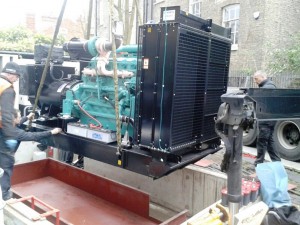 The Installation Team then carried out the re-positioning of the new 750kVA standby generator system, new silencer and new connection box followed by re-assembling all the previously removed cables from the old system for final connection to the institute’s mains power. Once all the required connections and electrical cables were re-installed and the existing enclosure replaced the new standby generator system was commissioned before our temporary standby generator set removed.
The Installation Team then carried out the re-positioning of the new 750kVA standby generator system, new silencer and new connection box followed by re-assembling all the previously removed cables from the old system for final connection to the institute’s mains power. Once all the required connections and electrical cables were re-installed and the existing enclosure replaced the new standby generator system was commissioned before our temporary standby generator set removed.
Our Commissioning Engineer undertook the pre-commissioning inspection and functional checks on the new system without the client present before completing in-depth final commissioning tests in accordance with all relevant BS and ISO standards. Such tests at the client’s site, with them present, included; carrying out a 3 hour resistive load bank test to check sufficient airflow through the canopy once replaced; a building test and an automatic changeover test, as scheduled with the client as it involved an agreed shut down and connection into the client’s switchboard, to ensure the new system initiates in a mains power outage as well as several other essential operating tests.
With the successful completion of the project only taking four weeks the client was hugely impressed and very pleased with the additional value engineering we incorporated into the project; retaining and reusing the existing acoustic enclose and fuel system ensured a huge cost savings; we also pro actively incorporated a permanent terminal box within the new installation allowing for an easy disconnection of the generator from the building supply or an easy method to connect a loadbank or a temporary generator should the new unit ever need to be taken out of service for maintenance or any other reason. The final and most important aspect of the works which the client was delighted with was that we kept site disruption to an absolute minimum. The client knew that the easiest solution in the restricted space might entail the use of a mobile 300 tonne crane to locate the new generator causing road closures and major disruption to traffic, residents and the University campus. However, by using our own specialist handling team, lifting equipment and specialist track way, this avoided the use of a mobile crane as well as achieving another sizeable cost saving.
The client didn’t hesitate to take out a service contract with us entitling them to a yearly service of the generator system by one of our team of Test Engineers as well as 24hr emergency maintenance support.
